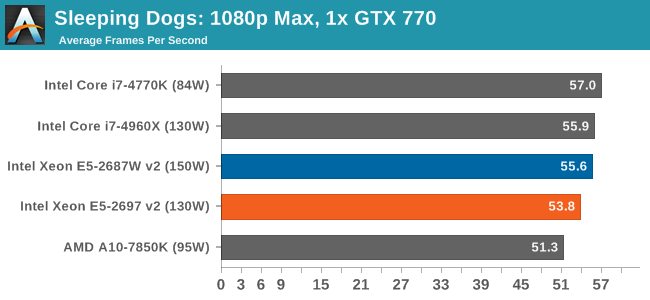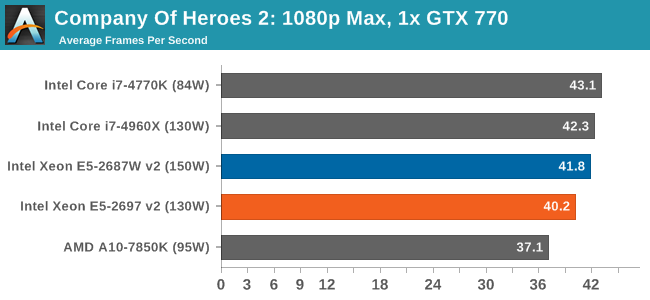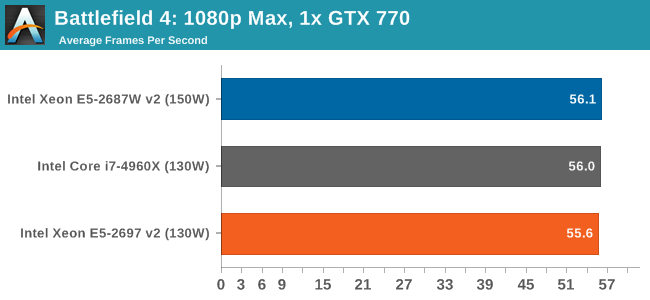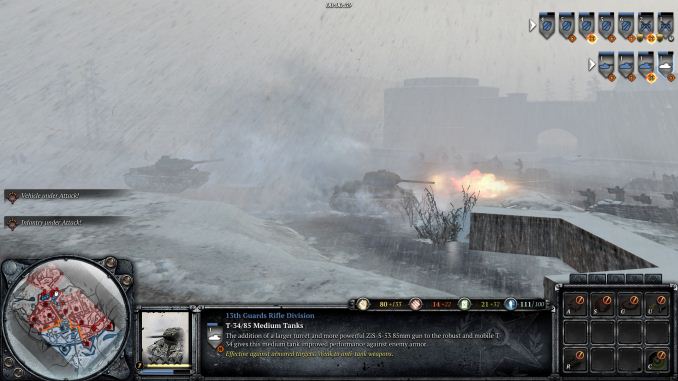Intel Xeon E5-2697 v2 and Xeon E5-2687W v2 Review: 12 and 8 Cores
by Ian Cutress on March 17, 2014 11:59 AM EST- Posted in
- CPUs
- Intel
- Xeon
- Enterprise
Sleeping Dogs
Sleeping Dogs is a benchmarking wet dream – a highly complex benchmark that can bring the toughest setup and high resolutions down into single figures. Having an extreme SSAO setting can do that, but at the right settings Sleeping Dogs is highly playable and enjoyable. We run the basic benchmark program laid out in the Adrenaline benchmark tool, and the Xtreme (1920x1080, Maximum) performance setting, noting down the average frame rates and the minimum frame rates.

| Sleeping Dogs, 1080p Max | ||
| NVIDIA | AMD | |
| Average Frame Rates |
|
|
| Minimum Frame Rates |
|
|
The lower frequency of the 12-core Xeon sometimes puts it behind in our Sleeping Dogs testing, usually in multiple GPU results such as 3x HD 7970 where it is 15 FPS behind both the i7-4960X and E5-2687W v2
Company of Heroes 2
The final gaming benchmark is another humdinger. Company of Heroes 2 also can bring a top end GPU to its knees, even at very basic benchmark settings. To get an average 30 FPS using a normal GPU is a challenge, let alone a minimum frame rate of 30 FPS. For this benchmark I use modified versions of Ryan’s batch files at 1920x1080 on Medium. COH2 is a little odd in that it does not scale with more GPUs.

| Company of Heroes 2, 1080p Max | ||
| NVIDIA | AMD | |
| Average Frame Rates |
|
|
| Minimum Frame Rates |
|
|
COH2 also acts somewhat CPU agnostic, although the higher frequency Xeon does have a small negligable boost over the E5-2697 v2. In all circumstances, the i7-4960X is competitive.
Battlefield 4
The EA/DICE series that has taken countless hours of my life away is back for another iteration, using the Frostbite 3 engine. AMD is also piling its resources into BF4 with the new Mantle API for developers, designed to cut the time required for the CPU to dispatch commands to the graphical sub-system. For our test we use the in-game benchmarking tools and record the frame time for the first ~70 seconds of the Tashgar single player mission, which is an on-rails generation of and rendering of objects and textures. We test at 1920x1080 at Ultra settings.

| Battlefield 4, 1080p Max | ||
| NVIDIA | AMD | |
| Average Frame Rates |
|
|
| 99th Percentile Frame Rates |
|
|
As we add more GPUs, AMD and NVIDIA act differently. With NVIDIA, more MHz gets better frame rates, whereas with AMD more cores wins out.
Conclusions
It would seem that in our gaming benchmarks, the higher frequency E5-2697W v2 is the more obvious choice over the 12-core E5-2697 v2. However in almost all circumstances, they perform on part with or below the i7-4960X, thus suggesting that our games tested cannot take advantage of more threads.












71 Comments
View All Comments
SirKnobsworth - Monday, March 17, 2014 - link
The LGA 2011 i7 chips don't have integrated graphics.Voldenuit - Monday, March 17, 2014 - link
Yeah, the Xeon E3s are great processors for enthusiasts/consumers.I was tossing up between an E3-1230 v3 (2MB more cache) or an i5 4670K (IGP, unlocked multiplier) in my latest build, and ended up with the 4670K because it had a $30 instant rebate, and I wanted quicksync (I know Ganesh says it has inferior transcode quality to x264, but I just need something quick and dirty for my phone, and honestly, I'm seeing more artefacts in the x264 samples he posted than in the QS samples). But it wasn't an easy decision.
Minor nitpick: you can get Xeon E3s with Intel HD graphics. Those are model numbers E3-12x5
http://ark.intel.com/products/family/78581/Intel-X...
mazzy - Monday, March 17, 2014 - link
Even more if you think about the facts that E3 xeons are i7 at i5 price... with ECC and VT tech... ok no OC...MrSpadge - Tuesday, March 18, 2014 - link
I'd take a CPU with IGP any day, unless it costs significantly more. Reason: increased resale value, even if I don't use the IGP myself.CrazyElf - Tuesday, March 18, 2014 - link
"I'd take a CPU with IGP any day, unless it costs significantly more. Reason: increased resale value, even if I don't use the IGP myself."I would not.
Reason is even when you use discrete, it uses additional power. IIRC for Sandy Bridge, a 3.6 GHz Sandy without the IGP switched on uses as much as a 3.4 GHz with the IGP on. Seeing that the graphics have become a bigger emphasis with Haswell, I expect that the IGP will be using a bigger percentage of the total power consumption with time.
austinsguitar - Monday, March 17, 2014 - link
okay...please tell me im not the only one who thinks this article is hilarious! look...if you are going to review two very expensive cpu's, don't test these against normal cpu's. It is shear idiocy to compare these to "desktop cpu's" because they are not....at all. Why can't anandtech do reviews on other affordable xeons and compare them all together. Also funny how they included AMD. That's cutejemima puddle-duck - Monday, March 17, 2014 - link
It's spelt 'sheer'. That aside, your ideas are intriguing to me, and I wish to subscribe to your newsletter.PEJUman - Monday, March 17, 2014 - link
you're the only one who think this article is hilarious.I thought/wished about this dataset previously. What if we simply go to XEONs and trade off clock for cores. i.e. the next logical progression from i7-4960X price bracket. obviously with no control over turbo bins & OC capability, the single thread is hosed. But wondered how many cores near-pro programs can really utilize.
I am just glad we get to see some comparisons. getting more XEON dataset would be interesting but I think it's beyond most of Anandtech reader usage partern.
austinsguitar - Monday, March 17, 2014 - link
You do indeed have a point about consumer cpu's and how they can overclock and are nifty to have for changing multiple options. but...the xeon market for average consumers needs to either be booming or a well kept secret. the 1230v3 is a fantastic cpu and can (for the most part) equal a 4770 for 240 dollars. I know it can not be overclocked, but people (about 70% of the market) do not give a care.But anandtech viewers are overly intelligent arnt we?
MrSpadge - Tuesday, March 18, 2014 - link
Had they not included these regular CPUs people would (rightfully) complain "what do these numbers mean without familiar comparison points?" Comparing 2 products to work out the real-world differences for some specific application is completely different from claiming they'd be equal.